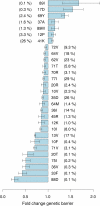Estimating the individualized HIV-1 genetic barrier to resistance using a nelfinavir fitness landscape
- PMID: 20682040
- PMCID: PMC2921410
- DOI: 10.1186/1471-2105-11-409
Estimating the individualized HIV-1 genetic barrier to resistance using a nelfinavir fitness landscape
Abstract
Background: Failure on Highly Active Anti-Retroviral Treatment is often accompanied with development of antiviral resistance to one or more drugs included in the treatment. In general, the virus is more likely to develop resistance to drugs with a lower genetic barrier. Previously, we developed a method to reverse engineer, from clinical sequence data, a fitness landscape experienced by HIV-1 under nelfinavir (NFV) treatment. By simulation of evolution over this landscape, the individualized genetic barrier to NFV resistance may be estimated for an isolate.
Results: We investigated the association of estimated genetic barrier with risk of development of NFV resistance at virological failure, in 201 patients that were predicted fully susceptible to NFV at baseline, and found that a higher estimated genetic barrier was indeed associated with lower odds for development of resistance at failure (OR 0.62 (0.45 - 0.94), per additional mutation needed, p = .02).
Conclusions: Thus, variation in individualized genetic barrier to NFV resistance may impact effective treatment options available after treatment failure. If similar results apply for other drugs, then estimated genetic barrier may be a new clinical tool for choice of treatment regimen, which allows consideration of available treatment options after virological failure.
Figures

References
-
- Vandamme AM, De Clercq E. Antiviral Therapy. chap 12. ASM Press, Washington, US; 2001. pp. 243–277.
-
- Vandamme AM, Sonnerborg A, Ait-Khaled M, Albert J, Asjo B, Bacheler L, Banhegyi D, Boucher C, BrunVezinet F, Camacho R, Clevenbergh P, Clumeck N, Dedes N, De Luca A, Doerr H, Faudon J, Gatti G, Gerstoft J, Hall W, Hatzakis A, Hellmann N, Horban A, Lundgren J, Kempf D, Miller M, Miller V, Myers T, Nielsen C, Opravil M, Palmisano L, Perno C, Phillips A, Pillay D, Pumarola T, Ruiz L, Salminen M, Schapiro J, Schmidt B, Schmit J, Schuurman R, Shulse E, Soriano V, Staszewski S, Vella S, Youle M, Ziermann R, Perrin L. Updated European recommendations for the clinical use of HIV drug resistance testing. Antivir Ther. 2004;9(6):829–48. - PubMed
-
- Wainberg MA, Brenner BG, Turner D. Changing patterns in the selection of viral mutations among patients receiving nucleoside and nucleotide drug combinations directed against human immunodeficiency virus type 1 reverse transcriptase. Antimicrob Agents Chemother. 2005;49(5):1671–1678. doi: 10.1128/AAC.49.5.1671-1678.2005. - DOI - PMC - PubMed
Publication types
MeSH terms
Substances
LinkOut - more resources
Full Text Sources
Medical

